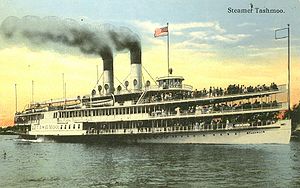The Tashmoo was a sidewheeler steamboat on Lake St. Clair and Lake Huron. It was famous for being one of the fastest ships, at the time, on the Great Lakes.
 Postcard from 1907 depicting the Tashmoo
| |
| History | |
|---|---|
| Name | S.S. Tashmoo |
| Namesake | Tashmoo Park[1] |
| Owner | White Star Steamship Co. |
| Builder | Detroit Shipbuilding Company, Wyandotte, Michigan |
| Launched | December 30, 1899 |
| Identification | US 145843 |
| Fate | Sank in 1936 and scrapped[2] |
| General characteristics | |
| Type | Sidewheel steamer |
| Tonnage | 1,344 GRT[2] |
| Length | 320 ft (100 m)[3] |
| Beam | 70 ft (20 m)[3] |
| Height | 22.3 ft (6.8 m) |
| Installed power | 2,500 ihp (1,900 kW) triple expansion steam engine[2] |
| Speed | ≥ 20 knots (37 km/h; 23 mph)[4] |
Construction
editThe Tashmoo was the first ship constructed in 1900 and was launched on December 31, 1899.[2] It was built by the Detroit Shipbuilding Company in Wyandotte, Michigan for Detroit's White Star Steamship Company. The Tashmoo was nicknamed the "White Flyer" and, because of the number of windows on the ship, the "Glass Hack."[2][5]
Operations
editThe Tashmoo's regular route was from Detroit to Port Huron, Michigan. It made several stops along the way, including at its namesake, Tashmoo Park.[6]
Steamboat race
editAfter a race between the City of Chicago and the City of Milwaukee in September 1900, a Chicago–newspaper boasted that the winner (the City of Chicago) was the "fastest on the lakes".[5] A paper in Detroit, Michigan subsequently listed nine vessels that could have easily beaten the City of Chicago. The list did not mention the Tashmoo. A. A. Parker, the president of the White Star Line, offered $1,000 to any ship that could beat the Tashmoo in a race. The president of the Cleveland Buffalo Transit Company accepted the challenge on behalf of his ship, the City of Erie. The course was 82 nautical miles (152 km; 94 mi) long and went from Cleveland, Ohio to Erie, Pennsylvania.[5]
The Tashmoo fell behind at the start of the race but quickly regained ground. It was forced to slow after going out of sight of the shore because the "wheelman was not used to steering [only] by compass."[5] The Tashmoo was later forced to slow again due to an overheating condenser.[5] The City of Erie eventually beat the Tashmoo by 45 seconds, but the Tashmoo had been catching up to the City of Erie before the finish.[3] A. A. Parker offered the owners of the City of Erie $10,000 for a rematch, but they refused the offer, although they later admitted that the Tashmoo was the faster ship.[5]
End of service
editOn December 8, 1927, the Tashmoo snapped its moorings during a gale and starting drifting up the Detroit River.[6] It collided with a ferry and was found further upstream, stopped by the Belle Isle Bridge.[6] Two tugboats pulled the Tashmoo away from bridge, but the cables broke again and the ship once again headed for the bridge. The ship was 10 yards (9.1 m) away from the bridge before the tugboats were able to get the Tashmoo secured again.[6] The ship was eventually repaired.
On June 18, 1936, the Tashmoo struck a submerged rock as it was leaving Sugar Island. The ship was able to dock in Amherstburg, Ontario, and be evacuated before it sank in 18 feet (5.5 m) of water.[6] It was eventually scrapped. It was entered into the National Maritime Hall of Fame in 1985.[7]
References
edit- ^ "New Lake Steamer Launched" (PDF). New York Times. December 30, 1899. Retrieved January 12, 2008.
- ^ a b c d e "Tashmoo". Marine Historical Society of Detroit. Retrieved January 12, 2008.
- ^ a b c "Steamer 'City of Erie' wins 100–mile race" (PDF). New York Times. June 5, 1901. Retrieved January 11, 2008.
- ^ Lloyd's Register of British and Foreign Shipping. 1905. p. 847.
- ^ a b c d e f Lochbiler, Don (June 26, 1999). "The race between two centuries". The Detroit News. Archived from the original on January 21, 2013. Retrieved January 12, 2008.
- ^ a b c d e Lochbiler, Don (February 7, 2000). "The SS Tashmoo and her date with doom". The Detroit News. Retrieved January 12, 2008.
- ^ "National Maritime Hall of Fame". United States Merchant Marine Academy. Archived from the original on September 15, 2010. Retrieved October 13, 2010.